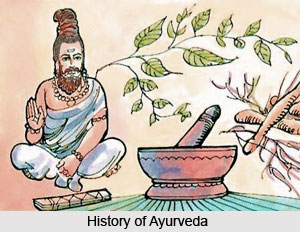 History of Ayurveda is long, copious and loaded with a rich past, deeply seated in the antiquities. Nearly 5,000 years ago the great sage, Vyasadeva for the first time penned downs the Vedas. The Vedas also included a branch called Ayurveda meaning "The Science of Life". Thus began the journey of Ayurveda as an oldest and most holistic treatment method. The history of Ayurveda states that steeped in mystic antiquity this ancient wisdom of curing, preventing disease and long life was a part of the spiritual tradition of a universal religion in India even before it was penned down.
History of Ayurveda is long, copious and loaded with a rich past, deeply seated in the antiquities. Nearly 5,000 years ago the great sage, Vyasadeva for the first time penned downs the Vedas. The Vedas also included a branch called Ayurveda meaning "The Science of Life". Thus began the journey of Ayurveda as an oldest and most holistic treatment method. The history of Ayurveda states that steeped in mystic antiquity this ancient wisdom of curing, preventing disease and long life was a part of the spiritual tradition of a universal religion in India even before it was penned down.Origin of Ayurveda
In India the origin of Ayurveda is as old as the religion, Hinduism. There were originally four main books of spirituality which also included topics like; health, astrology, spiritual business, government, army, poetry and behaviour. These books are known as the four Vedas; Rig Veda, Sama Veda, Yajur Veda and Atharva Veda. Ayurveda was a sub section attached to the Atharva Veda and is treated as Upaveda of Rig Veda and Antharveda (internal part) of Atharvana Veda. The history of Ayurveda claims that this sub section dealt with the ailments, injuries, fecundity, sanity and health and all the secrets of life, the ways of staying healthy, the paths of preventing diseases were revealed in the Rig Veda. Rig Veda shows the discussions on the Tridoshas - vata, pitta and kapha and the use of various herbs to cure the diseases. Panchabhuta, the five elements of creation - earth, water, fire, air, ether that forms the basis of universe also contours the base of all creation - this is the very kernel of Ayurveda which consists of three aspects of Ayurvedic knowledge known as the Tri-Sutras that includes cause of illness, symptoms and treatments of the disease.

Legends of Ayurveda
The history of Ayurveda also points out the celestial origin of this ancient science, which was once communicated to the Indian saints and sages. Myths unfold that Dhanvanatri, who later penned down Ayurveda, taught it to the sages. While according to another legend, the knowledge of healing originated from Lord Brahma who taught it to King Daksha, who further taught Lord Indra.
It was the time of restlessness when disease and death were creating havocs and human had no answer. It was this time when all great sages in order to find solution to this problem gathered. During this meeting Sage Bharadvaja came forward and learnt the ancient science of Ayurveda from Lord Indra. He then taught this science to Atreya, who further transmitted this knowledge throughout world. The history of Ayurveda states that later, it was Agnivesha, the disciples of Atreya wrote ‘Agnivesha Samhita’ which is still considered as the most comprehensive form of Ayurveda.
Ancient Texts on Ayurveda
There are two main re-organizers of Ayurveda whose works still exist intact today - Charaka and Sushruta. According to the history of Ayurveda, Charaka was the first man who based his Samhita on Agnivesha Samhita and further elaborated it with his interpretations and annotations. Precisely, ‘Charaka Samhita’ integrated the external as well as the internal cause of illness. Sushruta based his Samhita on the Dhanvanatri school of Ayurveda. In ‘Sushruta Samhita’ there is details discusses about various surgeries, burns, fractures, wounds and amputation. The complete discussion on human anatomy marks Sushruta Samhita as a contemporary treatise on Ayurveda. The history of Ayurveda however uncovers the third major treatise which is called the ‘Ashtanga Hridaya’. This is basically a summarizing version of the works of Charaka and Sushruta which was compiled by Vagbhata.
For more, visit the link below: